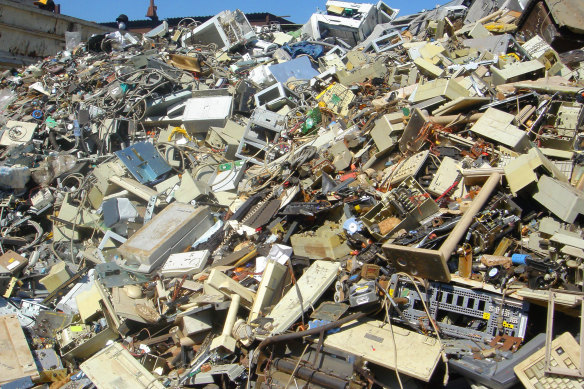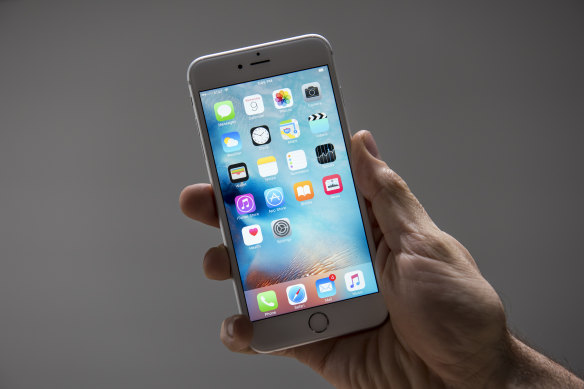How to get rid of your old devices in an environmentally friendly way
By Tim Biggs
Electronic waste continues to be a major issue in Australia, with multiple reforms to our recycling infrastructure failing to include any easy ways to save old phones and computers from the tip.
In 2020, the Global E-Waste Monitor reported that the volume of discarded computers, phones, televisions and other electronics had increased by 21 per cent between 2014 and 2019, and could double by 2030. It placed Australia as the fifth biggest e-waste producer in the world by kilograms per capita.

Almost all of the components in TVs and computers can be recycled, but almost none of them are.
The complications in reducing e-waste are manifold as consumption is growing, the diversity of different electronic devices is rising, gadget lifespans are shrinking and options for recycling e-waste within the home don’t exist.
In Victoria, it’s been illegal since 2019 to put e-waste in your household bins, while other states and territories strongly discourage it. But without a specific household bin for it to go in, it often ends up there anyway. According to Clean Up Australia, 88 per cent of TVs and computers in Australia end up in landfill, and e-waste is responsible for 70 per cent of the toxic chemicals found there.
Anthony Karam, chief executive of e-waste recycler Sircel, said an increased effort from end users had to come alongside more manufacturers building with recycling in mind.
“From our perspective, it’s an important change-of-thought process, for manufacturers to think in a more considered way about the recyclability of their products at the start of the design phase,” he said.
“By bringing recyclers, like us, into the conversation early we can use our expertise to help design products or parts of products, that won’t end up in landfill, allowing the commodities in these devices to be unlocked and given another life.”
He said that on average 40 per cent of e-waste is made up of hard plastics, which are hard to recycle but could easily be replaced by similar materials that can be reused.
“Once design changes have been tested by manufacturers, easier-to-recycle products could be implemented within a matter of months, if not within a year, and you will start to see results and the tangible difference when those products come to end of life.”
There’s also a growing movement to educate consumers and provide them with the tools to repair their devices where possible and prevent them going to landfill. Try searching for your device on ifixit.com, which will give you an idea of what you need and how difficult it will be, as well as step-by-step instructions.
If you are looking to get rid of your electronics and don’t want them to end up in the tip, here are some options.
Small items
The likes of batteries, light globes and ink cartridges should not be put in your regular recycle bin, but can be broken down for parts to be reused. Look for specially marked bins at your local library, or at certain retailers including Australia Post, Officeworks and IKEA.
For some items, there are also specialist recyclers you could use if they have a drop-off point close to you, including Ecobatt or B-cycle for batteries. Where possible, you could also consider using rechargeable batteries, LED light globes and ink tank printers, which fill up on liquid ink rather than cartridges.
Phones and smartwatches
Phones have a lot of valuable components that can be recycled, and it’s not too difficult to keep them out of landfill. For starters, if the phone works (or even if it doesn’t) you can likely sell it on eBay or through phone-buyers like Mazuma or Mobile Monster. Some retailers will also give you credit for your old phone when you’re buying a new one.
If it’s beyond saving, some drop-off points that accept batteries and other household goods also accept phones, and many phone manufacturers offer services to return your old handsets for recycling. If all else fails, Mobile Muster will mail you a satchel for free that you can use to send your devices in. As with any personal devices that can store data, always make sure your phone is reset and scrubbed of all your information before you let it go.

The Apple iPhone 6s - an old device which is now likely in landfill.Credit: Bloomberg
TVs and computers
As with phones, it’s possible you could find a way to give your old TV, laptop or computer a new lease on life if it isn’t completely broken; consider op shops or charities if you’re able to take the item to a store. But the federal government also funds a National Television and Recycling Scheme that in theory lets you recycle these items with minimal cost and effort. You need to contact your local council to find out how this is implemented near you, but often there’s a drop-off point or regular collection dates.
Laptop manufacturers are getting better at building more sustainable products, but for the most part, they’re still all glued together so that when one component goes (the battery for example), you’ll be tempted to turf the whole thing.
Consider getting a quote for repair from your local computer shop instead, so you can keep using it, or see if they’ll buy it for parts. You could always move to a more modular desktop PC if it’s an option, or look into computers designed for repairability like the Framework Laptop.
The big stuff
The likes of fridges, freezers and dishwashers have many recoverable materials, but also many hazardous materials that need to be disposed of correctly. Unfortunately, they’re also big and heavy, so getting rid of them when they break isn’t always easy.
Use a service like Planet Ark to find out if there are any recyclers near you that offer pick-ups, but note that commercial recyclers do usually charge a fee. Some councils also offer a pick-up service.
Some retailers, including Appliances Online, offer a free pickup of your old white goods at the same time your newly purchased replacement is delivered. And if you’re sticking with the same brand of appliance, some manufacturers also offer to take away the old when they deliver the new. Be sure to check this at their website in advance.
Get news and reviews on technology, gadgets and gaming in our Technology newsletter every Friday. Sign up here.